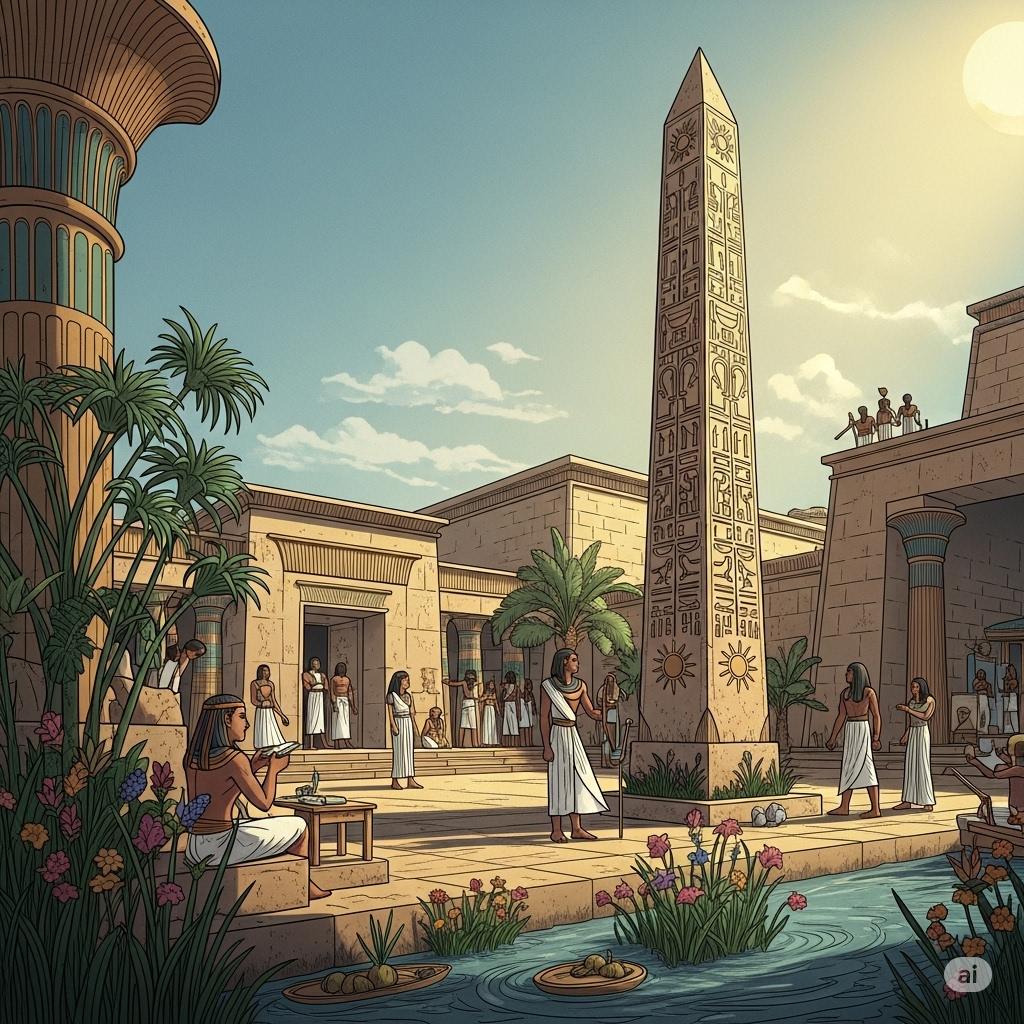Monuments of Sun, Power, and Eternity
Rising like fingers pointing to the sky, Egyptian obelisks stand as some of the most iconic and enduring symbols of ancient civilization. These towering stone monuments—often single pieces of solid granite—served not merely as architectural marvels but as profound religious symbols and political statements. Today, they grace city centers from Rome to Paris to Washington, D.C., but their roots reach deep into the sacred sands of ancient Egypt.
This article explores the construction, religious meaning, and far-reaching influence of obelisks in Egyptian culture and beyond.
What Is an Obelisk?
An obelisk is a tall, four-sided, narrow tapering monument that ends in a pyramidion—the pointed capstone—at the top. Typically carved from a single piece of stone, most often red granite from Aswan, these monuments were inscribed with hieroglyphs that commemorated pharaohs and honored the gods.
The ancient Egyptians referred to them as "tekhenu," while the term "obelisk" comes from the Greek obeliskos, meaning “little spit” or skewer—likely a reference to their shape.
Construction: Feats of Stone and Willpower
Building an obelisk was an extraordinary achievement in engineering and manpower, especially considering Egypt lacked iron tools or complex machines. Here's how it was done:
Quarrying: Workers at the Aswan quarries would use dolerite balls to pound out the shape of an obelisk from the bedrock. The famous Unfinished Obelisk, still lying in its quarry, shows how challenging this process was—one flaw in the stone could ruin the entire project.
Transport: Once carved, the obelisk was hauled—sometimes weighing over 300 tons—on sleds across desert sands to the Nile, then floated downstream on barges.
Erection: Using massive ramps, ropes, and human muscle, the obelisk would be stood upright—typically in pairs—at temple entrances or in sacred courtyards.
The construction was not merely about creating a monument; it was a display of divine favor and pharaonic power.
Religious Significance: Pillars of the Sun
Obelisks were deeply sacred to the ancient Egyptians. They were solar symbols, dedicated to the sun god Ra (or Re), and represented a ray of sunlight frozen in stone.
Symbolism:
The pyramidion, often gilded with electrum (a gold-silver alloy), would catch the sun’s rays at dawn.
Obelisks were seen as axis mundi—cosmic pillars that connected the earthly and divine realms.
Their form and function echoed the benben stone, the primordial mound from which life emerged in Egyptian creation myths.
Obelisks were often erected in pairs at temple entrances, particularly in temples to the sun god, such as the Temple of Amun-Ra at Karnak. The pharaohs used them to affirm their divine legitimacy and to ensure eternal remembrance.
Political and Dynastic Power
Beyond religion, obelisks also served as bold political statements. Pharaohs inscribed their names, titles, and achievements on their surfaces, often rewriting or erasing the deeds of predecessors. Erecting an obelisk was an act of both piety and propaganda.
Notable pharaohs associated with major obelisks include:
Hatshepsut – The female pharaoh who built some of the tallest obelisks at Karnak.
Thutmose III – Known for multiple obelisks, many of which were later moved abroad.
Ramses II – Inscribed his legacy across many stone monuments, including obelisks, to solidify his place in history.
Legacy and Global Influence
With the fall of ancient Egypt and the rise of empires like Rome, obelisks took on a second life as spoils of conquest and symbols of imperial grandeur. Roman emperors, fascinated by Egyptian culture, transported several obelisks to Italy, many of which still stand today.
Modern Locations of Ancient Obelisks:
Rome – Houses more ancient obelisks than Egypt, including the Lateran Obelisk, the tallest standing ancient Egyptian obelisk in the world.
Paris – The Luxor Obelisk in the Place de la Concorde was a gift from Egypt in the 19th century.
London – Cleopatra’s Needle, brought from Alexandria, stands by the Thames.
New York City – Another Cleopatra’s Needle stands in Central Park, also from the Temple of Heliopolis.
The symbolism of the obelisk as a marker of power and prestige has carried into modern architecture. The Washington Monument, though not a true obelisk by Egyptian standards, draws direct inspiration from its ancient predecessors.
Conclusion: The Obelisk as Eternal Flame in Stone
Obelisks are more than decorative monuments—they are the embodiment of a civilization’s spiritual and political ideals, carved into eternal stone. Rising from the sands of Egypt, they have become global symbols of enduring legacy, divine aspiration, and human ingenuity.
From temples in Thebes to city squares in the West, these ancient shafts of sunlight continue to cast long shadows—reminding us of a world where the line between the sacred and the monumental was etched in granite.







